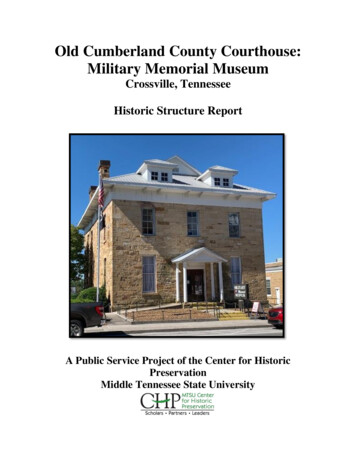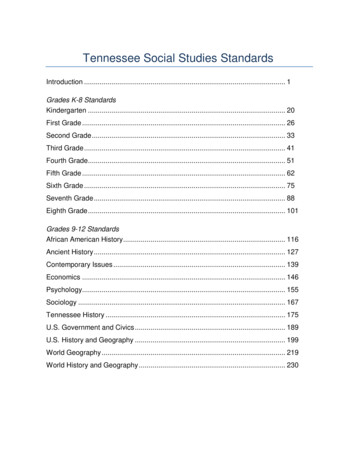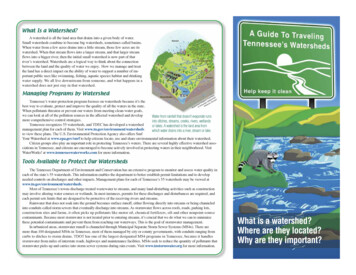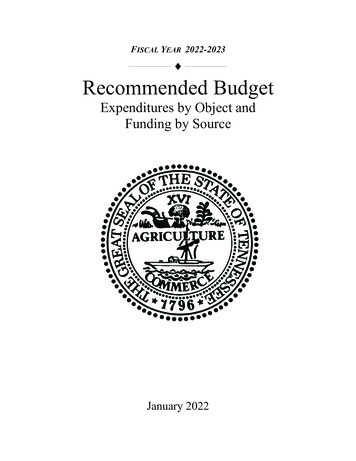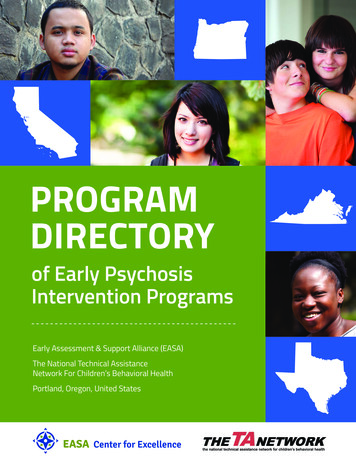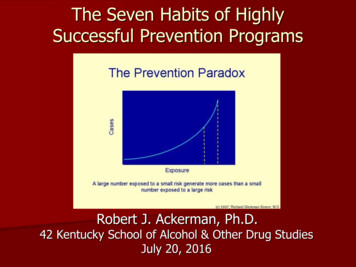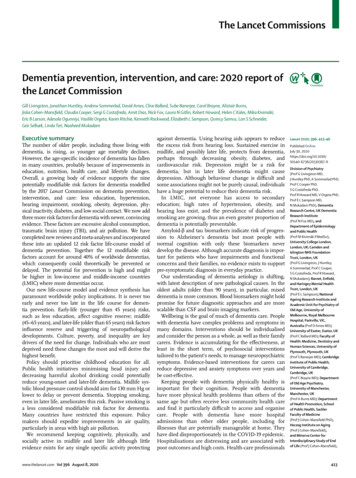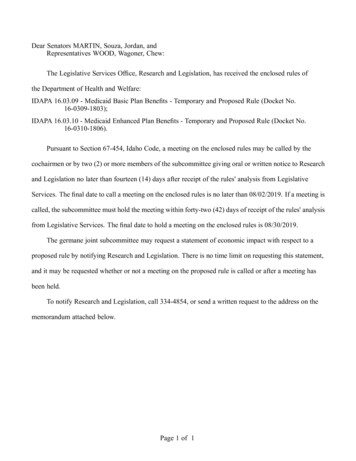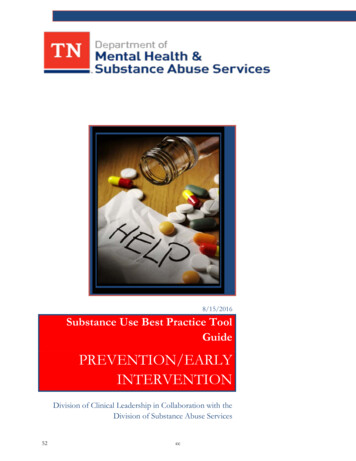
Transcription
8/15/2016Substance Use Best Practice ToolGuidePREVENTION/EARLYINTERVENTIONDivision of Clinical Leadership in Collaboration with theDivision of Substance Abuse Services52ec
Prevention/Early InterventionPreventionPrevention can be defined as any activity designed to avoid substance use and/or abuse and reduceits social and health consequences. Actions may be aimed at reducing demand as shown in healthpromotions, e.g., and/or reducing supply, for instance, making substances less available (MedinaMora, 2005).Preventive factors seek toenhance protective factorsand/or reduce risk factors(Kane & Ballue, 2013).Risk factors increase thelikelihood of high-riskbehaviors, which often result in negative outcomes. Protective factors, on the other hand, lower theprobability of high-risk behaviors and promote positive outcomes (Butler Center for Research,2010).Preventive factors seek to enhance protective factorsand/or reduce risk factors (Kane & Ballue, 2013).Prevention is critical in the reduction of negative impact and outcomes associated with substanceuse and abuse and messages have become one of the most effective prevention interventions. It hasbeen shown that consistent, pervasive messages to young people about substances can preventsubstance use and/or abuse. In fact, effective prevention not only routinely repeats the samemessages, but it is further delivered by multiple messengers—peers, parents, schools, and thecommunity (Butler Center for Research, 2010).The primary goal of prevention is to delay or prevent the onset of substance use and/or abuse.Delay alone is important. Research indicates youth that begin using substances prior to age 14 aresignificantly more likely to become substance dependent at some point in their lives (Butler Centerfor Research, 2010; CAPT, 2012). Thus, the prevention messages are paramount. Protective factorssuch as strong family bonds and proactive parenting additionally increase the probability thatsubstance use/abuse will be delayed (Butler Center for Research, 2010).In practice, there are essentially five models of substance abuse prevention, each based on adifferent set of underlying assumptions about behaviors of substance abuse and their motivations(Duncan & Gold, 1982).First, there is the law enforcement model. Prohibition laws played a substantial role along with thethreat or infliction of punishment to prevent substance abuse. This model was based on theassumption that substance abuse was moral issue and that people who abused substances must bepunished for their own good, not to mention the good of society. Also inherent in this model is thefact that certain substances are inherently evil or at least too potent for people to be allowed to use.Hence, only the threat of punishment could keep people from being tempted to experiment withsubstances and become hopelessly addicted. This model has not been successful. Actuallyprohibition of substances resulted in more substance abuse and more crime, along with a growth ina substance-rich black market (Duncan & Gold, 1982).The medical model is the second model. This model treats substance abuse as if it were aninfectious epidemic. It relies on early identification and isolation of people who abuse substancesbefore they can infect others. The model incorporates charts and pamphlets that tell parents andteachers how to identify substance-using/abusing teens. Strategies might consist of having parentssearch their teen’s rooms for substances or to allow strip search of school lockers when there is53ec
Prevention/Early Interventionadequate suspicion. Jails are replaced by involuntary treatment. Like the law enforcement model,neither has the medical model been successful. It has also been mentioned that users of substanceslabeled as such through this model might become a self-fulfilling prophecy and live up to theexpectations engendered by the label (Duncan & Gold, 1982).The third model is the educational model. This model assumes that substance abuse results frompoor choices made in ignorance of the hazards and effects of substances. Thus, it is anticipated thateducating people about the dangers of substance abuse will assist them in making the right decisionsand avoid substance abuse. Scare tactics as well as skill-building are applications of this model.Unfortunately substance education has not been the great success story either, especially not foryoung people (Duncan & Gold, 1982).Fourth is the psychosocial model. Substances are used as a means of coping with day-to-dayfrustrations and problems. Prevention then needs to provide opportunities to deal with those issues.Strategies for preventing substance use might include peer counseling, crisis hotlines, transcendentalmeditation , and the like. Activities such as adventure and self-expression are also greatalternatives to using substances based on this model (Duncan & Gold, 1982).The fifth and final model is the sociocultural model. Here the focus is the root of substance abusein the country, not in the individual person. The solution then is in changing communities, society,not in changing the individual. Societies that discriminate against the marginalized (e.g., ethnicminorities) should not expect to escape substance abuse. Societies that look the other way givengender discrimination, e.g., will not be able to prevent substance use/misuse. Societies that advertisepills as solutions to problems will find its youth turning to illicit substances for solutions (Duncan &Gold, 1982).The Office of National Drug Control Policy [ONDCP] Web site (n.d.) recognizes the value ofprevention efforts and promotes such approaches as the most cost-effective, common-sense ways toencourage healthy and safe communities. Research continues to show the relationship betweensubstance use and poorer academic performance, lost productivity, traffic-crash deaths, sexuallytransmitted infections (STI), hepatitis C, human papillomavirus (HPV), etc. Substance use furthercontributes to rates of human immunodeficiency virus (HIV) transmission and puts children at riskfor abuse and neglect. Preventing substance use and dependence before it ever begins can help savelives and reduce costs related to health care and criminal justice.Prevention PrinciplesThere are 16 principles ofprevention. They have beenThere are 16 prevention principles (NIDA, 2003).revised based on research fundedby the National Institute on DrugAbuse (NIDA) as well as the coreelements observed in research on effective prevention programs (NIDA, 2003). The principlesdictate that prevention programs:1. Should reverse or reduce risk factors while enhancing protective factors2. Should address all forms of substance use and/or abuse, in combination or alone, includingthe underage use of legal substances (e.g., alcohol or tobacco); the use of illicit drugs (e.g.,54ec
Prevention/Early Interventionheroin or marijuana); and the inappropriate use of prescription medications, substanceslegally obtained (e.g., inhalants), or over-the-counter drugs.3. Should speak to the type of substance abuse problem in the local community, strengthenidentified protective factors, and target risk factors that can be modified.4. Should be tailored to address risks to audience characteristics or specific populations, such asgender, ethnicity, and age to improve program effectiveness.5. If family based, should improve family relationships including bonding and incorporatepractice in developing, discussing, and enforcing family policies on substance abuse; trainingin substance information and education; and parenting skills.6. Might be designed to intervene as early as preschool to address risk factors for substance useand/or abuse, such as poor social skills, aggressive behavior, and academic difficulties.7. If designed for elementary school children, should target improvement of social-emotionaland academic learning to address risk factors for substance abuse, such as academic failure,early aggression, and school dropout. The educational component should focus on thefollowing: academic support, especially in reading; communication; emotional awareness; self-control; and social problem-solving.8. If designed for middle school/junior high or high school students, should enhance academicand social competence with the following : communication; substance resistance skills;oreinforcement of antidrug attitudes; andostrengthening of personal commitments against substance abuse. peer relationships; self-efficacy and assertiveness; and study habits and academic support.9. If aimed at the general public at key transition points, such as transition from elementaryschool to middle school, can produce beneficial effects even among high-risk children and55ec
Prevention/Early Interventionfamilies. These types of interventions do not single out risk populations and thus reducelabeling and increase bonding to school and community.10. If community based and a combination of at least two effective programs, they can be moreeffective than a single program alone.11. If community based and focused on populations in multiple settings, e.g., faith-basedorganizations, schools, and clubs, they are most effective when they present communitywide messages in each setting that are consistent.12. Should retain core elements of the original research-based intervention when communitiesadapt programs to match their needs, differing cultural requirements, or community norms.13. Should be long-term and provide repeated interventions (i.e., booster programs) to reinforcethe original prevention goals. It has been shown that gains from middle school preventionprograms diminish if there are no follow-up programs in high school.14. Should include teacher training on effective classroom management practices, such asrewarding appropriate student behavior. These techniques help to enhance academicmotivation, achievement, positive behavior, and school bonding in students.15. Demonstrate the greatest effectiveness when they employ interactive techniques such asparent role-playing and peer discussion groups that allow for active involvement in learningabout substance use and/or abuse and reinforcing skills.16. If research-based, they can be cost-effective. A savings of up to 10 in substance abuse hasbeen observed for each dollar invested in prevention (NIDA, 2003).NIDA’s principles for prevention are based on longitudinal research studies on the origins ofsubstance use/abuse behaviors as well as the common elements of effective prevention programs.In sum, the principles affirm: Prevention programs should reduce or reverse risk factors and enhance protective factors. Prevention programs should be tailored to address risks targeted to audience characteristicsor to the whole population. Prevention programs should be long-term, incorporating repeated interventions such asbooster programs to reinforce the original prevention goals (Medina-Mora, 2005).Levels of PreventionThe three types of prevention are: 56Primary – At this level, at-risk individuals are helped to avoid developing addictivebehaviors (NIDA, n.d.) so new cases are prevented (Kane & Ballue, 2013). This is the levelwhere every reasonable effort is made to stop substance abuse/use/misuse from happeningin the first place (Duncan & Gold, 1982). Primary care physicians are highly encouraged toreinforce this level of prevention efforts. Youth might be encouraged to seek out and/orec
Prevention/Early Interventionparticipate in educational and informational opportunities that address the consequences oftobacco and/or substance use. If programs such as Students Taught Awareness andResistance (STAR) are operating in the young person’s school, he or she might beencouraged to participate. These programs teach skills that help young people avoid highrisk activities. School based programs that involve youth supports such as peers, family, andcommunity, tend to raise the level of effectiveness (NIDA, n.d.). Such programs might bereferred to as multiple-component programs (Medina-Mora, 2005).Some experts have recommended using the Problem Oriented Screening Instrument forTeenagers (POSIT) to screen for substance use and development risk factors in youth(NIDA, n.d.). It can be administered to youth 12 to 19 years of age and is available from theNational Clearinghouse for Alcohol and Drug Abuse Information (NIDA, n.d.). However,the POSIT is lengthy (i.e., 139 items) and there is no computerized administration orscoring. Reliability estimates are acceptable, though lower for males on two of the subscales(Knight, Goodman, Pulerwitz, & DuRant, 2001). Screening should assist with theidentification of risk factors, which falls under primary prevention (Kane & Ballue, 2013).This type of prevention should be considered for adults who might be entering or involvedin risky situations, e.g., the adult is in or planning to enter a close relationship with anindividual who abuses alcohol or other substance, as well. It is also imperative that womenof childbearing potential are reminded about the extreme risks associated with substance useand/or abuse during pregnancy (NIDA, n.d.).Because of the potential impact of this level of prevention, it has been said that its priorityneeds to be raised. The 2013 budget of the Substance Abuse and Mental Health ServicesAdministration (SAMHSA) for treatment was nearly four times the prevention budget, e.g.In dollar amounts, the 2013 SAMHSA treatment budget was 1,813 million, compared to 470 million for the prevention budget (Kane & Ballue, 2013). Additionally, this level ofprevention would reduce the amount of dollars spent on “preventable law enforcement,health care, crime, and other costs” (NIDA, 2007)57 Secondary – This level of prevention involves uncovering potentially harmful substance usebefore onset of overt problems or symptoms (NIDA, n.d.). Here new cases are identifiedvery early and typically before the affected individual notices that there may be a problem.At this level, the clinician would screen for the disease and help the affected individual seekout appropriate resources (Kane & Ballue, 2013). This level where early treatment occurs(Duncan & Gold, 1982). Tertiary – Treatment of the medical consequences of substance abuse and facilitation ofenrollment into treatment to minimize further disability is the aim of this level of prevention(NIDA, n.d.). Rehabilitation as well as prevention of disability or death is the aim of thislevel of prevention (Duncan & Gold, 1982).ec
Prevention/Early InterventionPreventive InterventionsThese interventions, as described in the 2009 Preventing Mental, Emotional, and Behavioral Disordersamong Young People: Progress and Possibilities, were classified based on the people they aim to reach. Itshould be noted that most preventive interventions are aimed at young people because earliermessages do a better job of delaying or preventing the onset of substance use and/or abuse.Universal preventive interventions focus on a population at large (Kane & Ballue, 2013; MedinaMora, 2005). For example, using direct messaging to women or those who might influence womenaddressing elimination or reduction of alcohol consumption during pregnancy fits this type ofpreventive intervention. There are likely many pamphlets, videos, public service announcements(PSAs), pins, and buttons to communicate the message. There may even be classes for children,educating them on the benefits of alcohol avoidance (Clarren & Salmon, 2010). Selectivepreventive interventions are targeted toward specific individuals or groups (Kane & Ballue, 2013).The risk of developing a substance use disorder (SUD) for these targeted individuals or groups issignificantly higher than average. These individuals or groups are at imminent or lifetime risk ofdeveloping an SUD (Medina-Mora, 2005). Motivational interviewing and brief interventions asincorporated in SBIRT that encourage change in risky substance use patterns are examples of suchinterventions (Clarren & Salmon, 2010). Indicated preventive interventions are aimed atextremely high-risk persons with early signs, symptoms, or biological markers that are precursors butnot yet diagnosable (Kane & Ballue, 2013).Examples of Universal Prevention:Community policies that promote access to early childhood education and education for physicianson prescription drug misuse and preventive prescribing practices are examples of universalprevention (CAPT, 2012).One program that fits universal prevention description is Guiding Good Choices (GGC).Formerly known as Preparing for the Drug-Free Years, the curriculum educates parents on how tostrengthen bonding in their families and reduce risk factors. The parents are engaged in five, twohour sessions that focus on setting clear expectations, monitoring behavior, and maintainingdiscipline; family involvement and interaction; and other bonding and family managementapproaches (NIDA, 2003).Examples of Selective Prevention:Providing peer support groups for adults with a history of substance abuse or prevention educationfor new immigrant families living in poverty with their young children are examples of selectiveprevention (CAPT, 2012). Focus on Families (FOF) is a notable selective program. Designed forparents receiving methadone treatment and their children, the program seeks to reduce parents’ useof illegal substances and teaches family management skills to reduce their children’s risk for futuredrug abuse. It has been demonstrated to show early reduction in family-related risk factors with anoverall trend toward positive program effects on child outcomes (NIDA, 2003).Examples of Indicated Prevention:Among indicated prevention strategies are screening, consultation, and referral for families of olderadults admitted to emergency departments with potential alcohol-related injuries, as well asinformation and referral for young adults who violate community and/or campus policies onalcohol and drugs (CAPT, 2012).58ec
Prevention/Early InterventionProject towards No Drug Abuse (Project TND) is an indicated prevention intervention. Ittargets young people of high school age who attend traditional or alternative high schools. Thisprogram is designed to prevent the transition from drug use to drug abuse through the considerationof developmental issues faced by older youth (NIDA, 2003).Additionally there are tiered approaches to substance abuse prevention. It is believed that thisapproach to service delivery provides individuals a better understanding of the linkages betweendifferent parts of the system, relative to level of competence/sophistication and need(TADPEMDG, 2010). Many tiered programs incorporated all three levels of intervention. Anexample is the Adolescent Transitions Programs (ATP). Designed to provide preventionservices to students in middle and junior high school and their parents, ATP includes all three levelsof prevention. The universal level is directed to parents of all youth in a school and shows up as aFamily Resource Center. The Family Check-Up is the selective intervention that offers both familyassessment and professional support. The indicated level yields direct professional help to thefamily. Some tiered approaches incorporate only two of the three intervention levels (NIDA, 2003).Prevention Strategies Unique to Alcohol.The preconception period is the time that child-bearing women should be screened for alcohol useand/or abuse and, if necessary, offered brief interventions and/or referral to treatment to reduce orcompletely stop alcohol consumption. No evidence-based studies even hint that any amount ofalcohol use is safe during pregnancy, so educating and intervening early is critical (Keegan, Parva,Finnegan, Gerson, & Belden, 2010). Social regulations have demonstrated effectiveness asprevention strategies. Especially effective has been measures that limit the availability of alcoholthrough establishment of a minimumlegal age for consumption, e.g.Regulations on driving and drinkingSocial regulations have demonstratedhave also shown effectiveness,effectiveness as (alcohol) prevention strategiesincluding institution of sobriety check(Medina-Mora, 2005).points and random breath testing.Regulation of promotion, whichincludes control of content oradvertising bands have some effect if they are monitored and enforced. Persuasion and educationthrough the use of warning labels, e.g., have shown changes in attitudes and knowledge, though theeffect on drinking has not been sustained. Integrated approaches appear to be most effective(Medina-Mora, 2005).Environmental Prevention.Many of the prevention approaches aimed at delaying or preventing alcohol use fall under the rubricof environmental prevention. This form of prevention employs policy interventions to create analcohol environment that supports safe, healthy behavior. Research over several decadesdemonstrates that these type of policy reforms work. They have been especially successful inreducing problems associated with youth drinking (AlcoholPolicyMD.com, 2005).The following are examples of environmental prevention approaches: 59Decreasing the number of alcohol outlets in a community. Reduces the rates of alcohol-related youth violenceec
Prevention/Early Intervention Holding retailers liable for damage inflicted on individuals by underage and/or intoxicatedpatrons. Responsible server practices are promoted and alcohol-related crashes are reduced Increasing taxes on alcohol and reducing discount drink specials Reduces hazardous and heavy drinking among high school and college students Increasing enforcement of laws prohibiting sales to underage drinkers Reduces access to alcohol by young people Increasing the minimum legal drinking age to 21 Reduces alcohol-related motor vehicle crashes involving young people Reducing the amount of youth exposure to alcohol advertising and increasing the number ofalcohol counter-ads Positively impacts beliefs and intentions young people have regarding alcohol useand may affect their decisions about drinking (AlcoholPolicyMD.com, 2005) Reduce the number of public settings where drug use is occurring Directed patrols, proactive arrests, and problem-solving at high-crime “hot spots”have served to reduce crime associated with substance use. Reduce the availability of drug paraphernalia in retail alcohol outlets This effort has shown to be effective in ensuring merchant compliance with existinglaws (Sonoma County Department of Health Services, 2007).Environmental approaches are typically implemented at the local level in response to communitypressure and concern for action. These strategies serve to complement rather than replace strategiesthat target individual behavior (e.g., social norms and other educational programs). Environmentalapproaches enhance individually based strategies, creating a social climate that reinforces theeducational messages (AlcoholPolicyMD.com, 2005).The community coalitions program is one through which Substance Abuse Prevention Coalitions(SAPCs) have demonstrated their understanding of the Strategic Prevention Framework (SPF) andthe capacity to complete a comprehensive community plan that includes: an Assessment of Need;Capacity Assessment; Planning Process; Implementation Plan; and Evaluation Plan as described bythe SAMHSA’s SPF process. Environmental strategies incorporate prevention efforts aimed atchanging or influencing community conditions, standards, institutions, structures, systems andpolicies. The TDMHSAS utilizes the SPF to assist community coalitions and prevention providersin developing the infrastructure needed for community‐based, public health approaches that canlead to effective and sustainable reductions in alcohol, tobacco and other drug (ATOD) use andabuse (S. Cooper, June 24, 2016, personal communication).60ec
Prevention/Early InterventionPrevention ResourcesNational Substance Abuse Prevention Month.The month of October was designated through Presidential Proclamation as national SubstanceAbuse Prevention Month in 2011. This was the first time for such a designation and allowed for afull-month observance of the role that substance abuse prevention plays in promoting healthy andsafe communities. This month is a time of tribute to everyone that works to prevent substanceabuse in communities. It further is a time for individuals to rededicate themselves to building asafer, drug-free country (ONDCP, n.d.).National Prevention Week.This time is set aside to increase public awareness and action around substance abuse. The goalsare: 1) foster collaboration and partnerships with national and federal entities dedicated to behavioraland public health; 2) disseminate and promote quality behavioral health publications and resources;and 3) involve communities in implementing prevention strategies while raising awareness ofbehavioral health issues (SAMHSA, 2014).The third week in May has been set aside each year. The timing allows schools to take part inprevention-themed events in advance of the end of the school year, thus giving the opportunity toraise awareness for students across all ages. Youth drug use, especially alcohol, cigarette, andmarijuana use, spikes between spring and summer so this week is a pivotal time to provide educationto the young people and their families. Communities are asked to get involved in this week.Provide health fairs, block parties, educational assemblies, town hall meetings—the list can go onand on—to help raise awareness about the importance of preventing substance use/abuse(SAMHSA, 2014)." I Choose" Project.During National Prevention Week each year, individuals get to “choose” how to be a positiveexample, make a difference, and inspire other people. And it’s easy to do. The individual takes apicture of himself/herself holding a sign showing a personal message about why he or she believessubstance abuse prevention is important. Then the person should send the photo/message toNewMedia@samhsa.hhs.gov. The following information should be included in the message: NameStateZip codeThe "I Choose" message with the individual’s photo.Optional: Include an organizational name.When the photo/message is received, SAMHSA will review it for posting to the "I Choose" photogallery. Make certain that the photo/message does not violate conditions set forth for submission(SAMHSA, 2014).61ec
Prevention/Early InterventionCoalition for Healthy and Safe Campus Communities(CHASCo).The Coalition for Healthy and Safe Campus Communities (CHASCo) is a prevention servicedesigned to address the problem of high-risk drinking among college students and young adults inthe state. According to the National Institute on Alcohol Abuse and Alcoholism’s (NIAAA’s)Update on College Drinking report, these students continue to demonstrate disturbing increases inunhealthy and binge drinking driving while intoxicated, and alcohol-related injuries and deaths. Thereport also highlighted the fact that college students continue to put themselves at risk with theirlevel and frequency of alcohol consumption. Moreover, college students that do not drink are stillexposed to negative alcohol-use consequences, including assaults, increased traffic crashes, propertydamage, and other crimes (TDMHSAS, 2013).CHASCo’s vision is to be recognized nationally as a model for effective statewide coalitions ofinstitutions of higher education that address campus safety and prevention issues. They proactivelyaddress these issues by providing high-quality consultation and training, research support, technicalassistance, and policy development to member institutions. Further, CHASCo actively seekspartnerships with community and state agencies to assist campuses in having a variety of options inalignment with their alcohol, substance, and violence prevention efforts (CHASCo Web site, n.d.).Prevention services are provided at various campuses across the state—public as well as private,four-year versus two year, and in each of the three grand regions. Funding is provided throughTDMHSAS (TDMHSAS, 2013).National Youth Anti-Drug Media Campaign.This campaign was established by Congress in 1998 to prevent and reduce youth drug use. Originallythere were two distinct areas of focus: a teen-targeted Above the Influence (ATI) Campaign, and ayoung adult-targeted Anti-Meth Campaign. The campaign was later redirected and expanded tofocus on marijuana use (GAO, 2006). Federal oversight has ceased and the campaign is currentlyaffiliated with the non-profit Partnership for Drug-Free Kids (Abovetheinfluence.com, n.d.).Above the Influence (ATI).This brand was created to strengthen the anti-drug beliefs of young people. It was designedto speak to teens, encouraging them to live “above the influence” of substances, includingalcohol, and to reject the use of any substance that slows or hinders reach of their life goals.Early reports about the effectiveness of the ATI media campaign were not favorable. Thoseresults indicated that no campaign exposure effects were found on rates of quitting or usefor prior users of marijuana (GAO, 2006). Hence, an ATI media campaign re-launchoccurred in 2010. This campaign was much broader in scope and incorporated nationallevel television, Internet advertising, and a strong online presence through an ATI Facebookpage, AboveTheInfluence.com, and the Above the Influence (ATI) YouTube channel.More than 75 percent of young people said this re-launched message spoke to someone likethem, regardless of gender, ethnicity, or race. Results from the re-launch were also morepositive. Young people in the new ATI campaign were observed to be less likely to initiateuse of marijuana compared to those who had not been exposed to the campaign. Moreover,the young people who viewed the ads were more likely than their peers to say that marijuana62ec
Prevention/Early Interventionuse was not consistent with being independent and autonomou
If research-based, they can be cost-effective. A savings of up to 10 in substance abuse has been observed for each dollar invested in prevention (NIDA, 2003). NIDA's principles for prevention are based on longitudinal research studies on the origins of substance use/abuse behaviors as well as the common elements of effective prevention programs.

